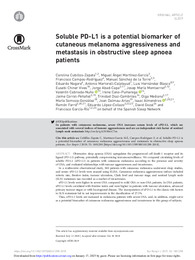Please use this identifier to cite or link to this item:
https://hdl.handle.net/11000/35173Full metadata record
| DC Field | Value | Language |
|---|---|---|
| dc.contributor.author | Cubillos-Zapata, Carolina | - |
| dc.contributor.author | Martínez-García, Miguel Ángel | - |
| dc.contributor.author | Campos-Rodríguez, Francisco | - |
| dc.contributor.author | Sánchez de la Torre, Manuel | - |
| dc.contributor.author | Nagore, Eduardo | - |
| dc.contributor.author | Martorell-Calatayud, Antonio | - |
| dc.contributor.author | Hernandez Blasco, Luis M. | - |
| dc.contributor.author | Chiner, Eusebi | - |
| dc.contributor.author | Abad Capa, Jorge | - |
| dc.contributor.author | Montserrat, Josep María | - |
| dc.contributor.author | CABRIADA, VALENTIN | - |
| dc.contributor.author | Cano-Pumarega, Irene | - |
| dc.contributor.author | corral-peñafiel, jaime | - |
| dc.contributor.author | Díaz-Cambriles, Trinidad | - |
| dc.contributor.author | Mediano, Olga | - |
| dc.contributor.other | Departamentos de la UMH::Medicina Clínica | es_ES |
| dc.date.accessioned | 2025-01-23T19:54:16Z | - |
| dc.date.available | 2025-01-23T19:54:16Z | - |
| dc.date.created | 2019 | - |
| dc.identifier.citation | European Respiratory Journal. 2019 Jan 31;53(2):1801298 | es_ES |
| dc.identifier.issn | 1399-3003 | - |
| dc.identifier.issn | 0903-1936 | - |
| dc.identifier.uri | https://hdl.handle.net/11000/35173 | - |
| dc.description.abstract | Obstructive sleep apnoea (OSA) upregulates the programmed cell death-1 receptor and its ligand (PD-L1) pathway, potentially compromising immunosurveillance. We compared circulating levels of soluble PD-L1 (sPD-L1) in patients with cutaneous melanoma according to the presence and severity of OSA, and evaluated relationships with tumour aggressiveness and invasiveness.In a multicentre observational study, 360 patients with cutaneous melanoma underwent sleep studies, and serum sPD-L1 levels were assayed using ELISA. Cutaneous melanoma aggressiveness indices included mitotic rate, Breslow index, tumour ulceration, Clark level and tumour stage, and sentinel lymph node (SLN) metastasis was recorded as a marker of invasiveness.sPD-L1 levels were higher in severe OSA compared to mild OSA or non-OSA patients. In OSA patients, sPD-L1 levels correlated with Breslow index and were higher in patients with tumour ulceration, advanced primary tumour stages or with locoregional disease. The incorporation of sPD-L1 to the classic risk factors to SLN metastasis led to net improvements in the classification of 27.3%.Thus, sPD-L1 levels are increased in melanoma patients with severe OSA, and, in addition, might serve as a potential biomarker of cutaneous melanoma aggressiveness and invasiveness in this group of subjects. | es_ES |
| dc.format | application/pdf | es_ES |
| dc.format.extent | 11 | es_ES |
| dc.language.iso | eng | es_ES |
| dc.publisher | European Respiratory Society | es_ES |
| dc.rights | info:eu-repo/semantics/openAccess | es_ES |
| dc.rights | Attribution-NonCommercial-NoDerivatives 4.0 Internacional | * |
| dc.rights.uri | http://creativecommons.org/licenses/by-nc-nd/4.0/ | * |
| dc.title | Soluble PD-L1 is a potential biomarker of cutaneous melanoma aggressiveness and metastasis in obstructive sleep apnoea patients | es_ES |
| dc.type | info:eu-repo/semantics/article | es_ES |
| dc.relation.publisherversion | 10.1183/13993003.01298-2018 | es_ES |

View/Open:
Soluble PD-L1 is a potential biomarker of cutaneous melanoma aggressiveness and metastasis in obstructive sleep apnoea patients.pdf
630,25 kB
Adobe PDF
Share:
.png)
